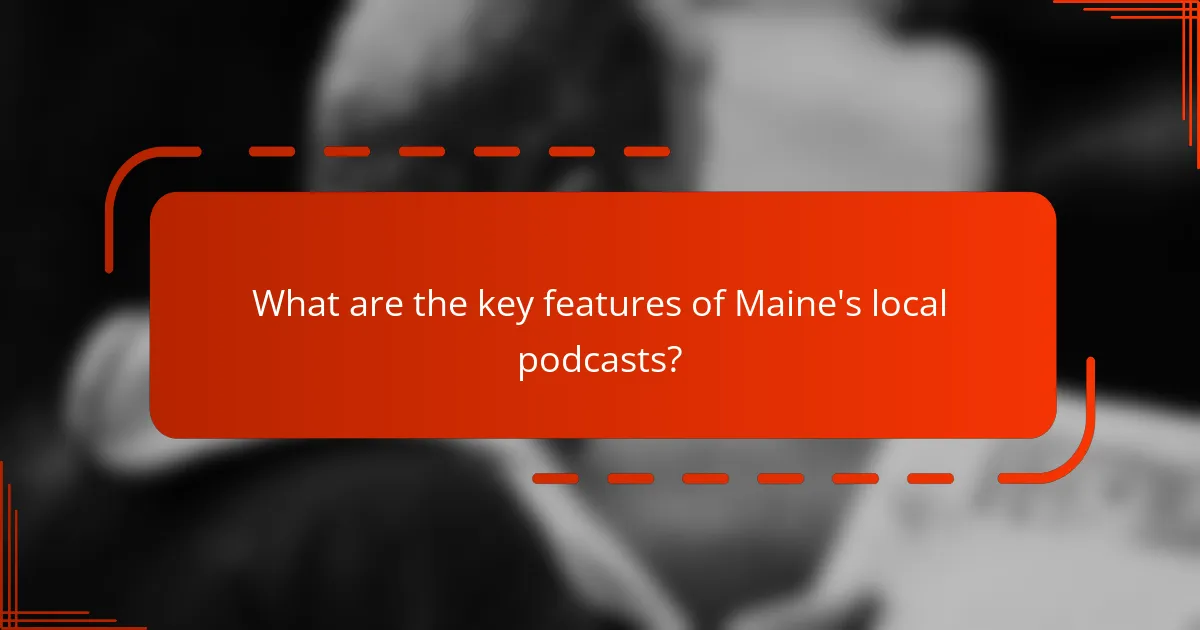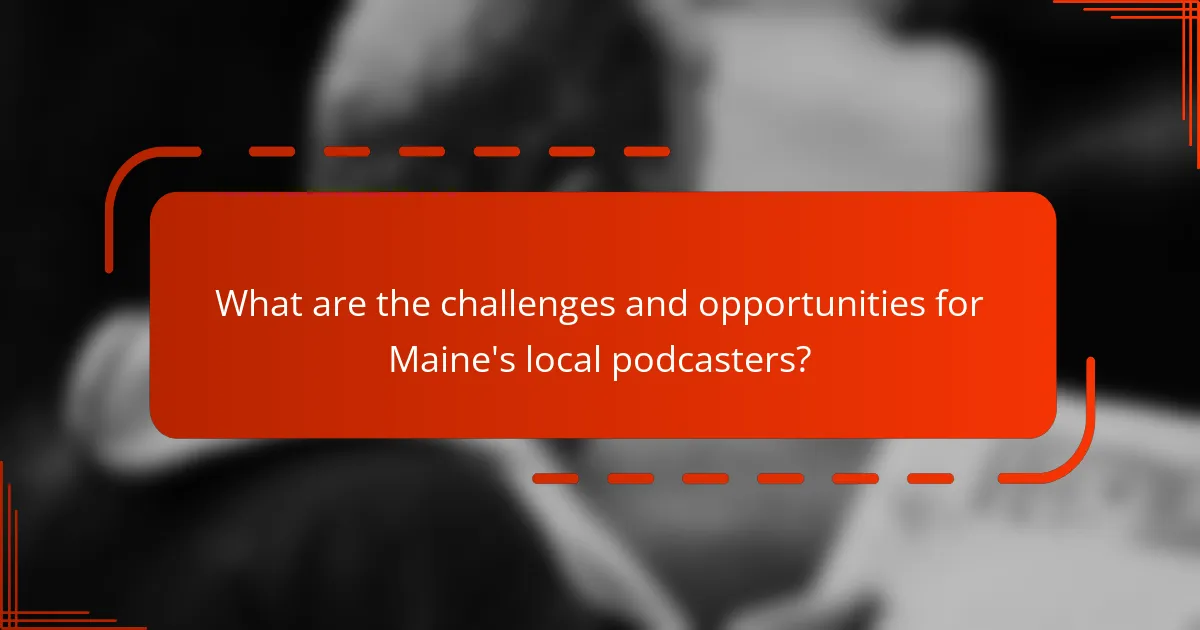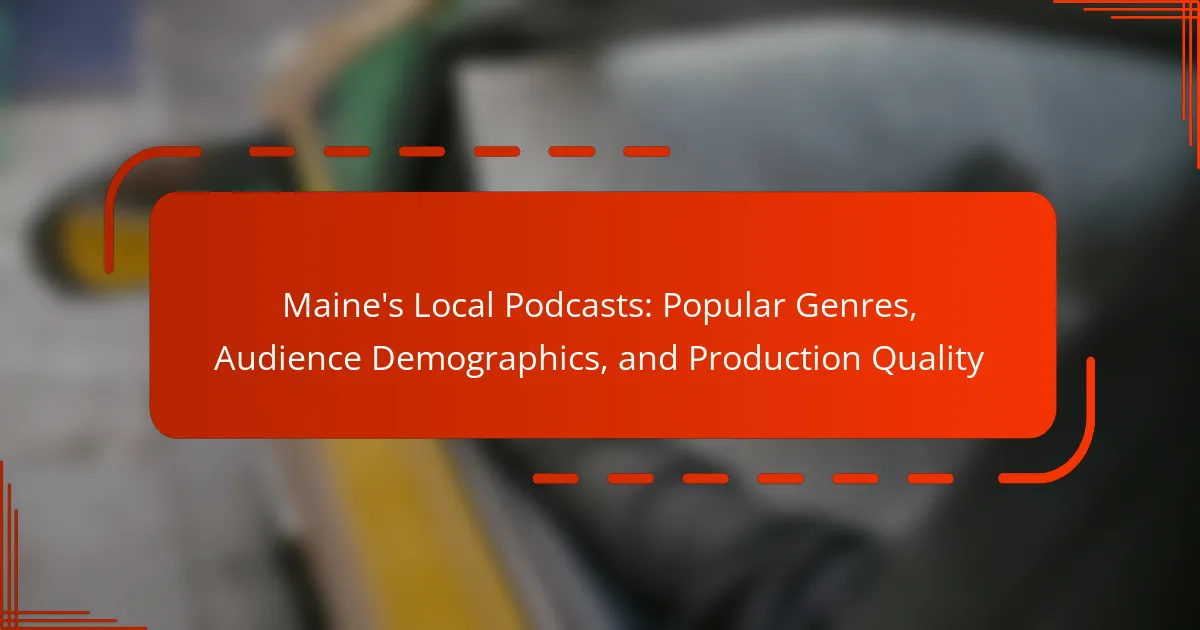Maine’s local podcasts serve as a platform for diverse content that reflects regional interests, including local news, culture, and events. These podcasts often feature interviews with community leaders and experts, fostering a sense of connection among residents. While production quality varies, storytelling remains a key focus, engaging a mixed audience demographic with a notable rise in younger listeners. Challenges such as limited funding and competition exist, but the unique cultural landscape of Maine offers rich opportunities for podcasters to attract dedicated listeners and expand their reach through digital platforms. Overall, local podcasts significantly enhance community engagement and connection.

What are the key features of Maine’s local podcasts?
Maine’s local podcasts feature diverse content tailored to regional interests. They often highlight local news, culture, and events. Many podcasts include interviews with community leaders and experts. The production quality varies, with some shows using professional equipment. A strong focus on storytelling is common among successful podcasts. They also engage listeners through social media platforms. Audience demographics show a mix of age groups, with a growing interest among younger listeners. Local podcasts often foster a sense of community and connection among residents.
How do popular genres shape the podcasting landscape in Maine?
Popular genres significantly shape the podcasting landscape in Maine by influencing content creation and audience engagement. True crime and storytelling are among the most popular genres in Maine, attracting large listener bases. These genres drive local podcasters to focus on regional stories and issues, fostering community connection. Additionally, genres like health and wellness resonate with listeners, reflecting the state’s values on holistic living. The popularity of these genres also impacts advertising strategies, as brands align with content that appeals to local interests. Furthermore, the growth of niche genres, such as outdoor adventure podcasts, highlights Maine’s unique culture and environment. This genre diversity enhances the overall podcasting ecosystem, encouraging more creators to enter the market.
What are the most listened-to podcast genres in Maine?
The most listened-to podcast genres in Maine include true crime, comedy, and news. True crime podcasts appeal to listeners with their intriguing stories and investigative narratives. Comedy podcasts provide entertainment and humor, attracting a broad audience. News podcasts keep listeners informed about local and national events. According to recent surveys, these genres consistently rank high in listener preference across the state.
How do local interests influence podcast genre popularity?
Local interests significantly influence podcast genre popularity by aligning content with regional preferences. In Maine, for example, outdoor and nature-related podcasts are popular due to the state’s rich natural resources. Local news and community issues also attract listeners who seek relevant information. The unique cultural heritage of Maine drives interest in podcasts discussing local history and traditions. According to a survey by Edison Research, regional content resonates more with listeners, increasing engagement. This trend is supported by the rise of localized podcasts that cater to specific community interests, making them more appealing to the audience.
What audience demographics are prevalent among Maine’s podcast listeners?
Maine’s podcast listeners predominantly include adults aged 18 to 34. This age group represents a significant portion of the audience. Additionally, many listeners are college-educated professionals. A majority of the audience is also from urban areas, particularly Portland. Statistics indicate that around 60% of podcast listeners in Maine are female. Moreover, the demographic shows a strong interest in local news and cultural content. Research from the Pew Research Center highlights these trends in podcast consumption across various regions, including Maine.
What age groups are most engaged with local podcasts?
Adults aged 25 to 54 are the most engaged with local podcasts. This age group represents a significant portion of podcast listeners. According to a 2023 survey by Edison Research, 49% of podcast consumers fall within this demographic. Additionally, younger adults aged 18 to 24 show increasing engagement, accounting for about 20% of the audience. Local podcasts appeal to these age groups due to their relevance and community focus.
How does gender distribution affect podcast listenership in Maine?
Gender distribution significantly impacts podcast listenership in Maine. Research indicates that women are more likely to engage with podcasts than men in the state. A study by Edison Research shows that 54% of podcast listeners in Maine are female. This higher percentage among women suggests that content appealing to female audiences may see greater success. Conversely, male listeners tend to prefer specific genres, such as sports and technology. Understanding these dynamics can help podcast creators tailor their content to meet the preferences of different gender demographics.
What role does production quality play in the success of Maine’s podcasts?
Production quality is crucial for the success of Maine’s podcasts. High production quality enhances listener engagement and retention. Clear audio, professional editing, and well-structured content contribute to a positive listening experience. According to a survey by Podcast Insights, 70% of listeners prefer podcasts with high production values. Additionally, podcasts with better sound quality are more likely to receive positive reviews and recommendations. This can lead to increased visibility and audience growth. Overall, production quality directly influences listener perception and the overall success of podcasts in Maine.
How do production values differ among popular podcasts in Maine?
Production values among popular podcasts in Maine vary significantly. Some podcasts feature high-end audio equipment and professional editing, leading to crisp sound quality. Others may rely on basic recording tools, resulting in less polished audio. The use of sound effects and music also differs; some shows integrate them effectively, while others do not. Additionally, the frequency of episodes impacts production quality; more frequent releases may sacrifice audio refinement. Notably, podcasts with larger budgets can afford better production resources. This disparity influences listener experience and engagement levels.
What equipment and techniques are commonly used by Maine podcasters?
Maine podcasters commonly use USB microphones, audio interfaces, and digital audio workstations (DAWs). USB microphones provide ease of use and good sound quality. Popular models include the Blue Yeti and Audio-Technica AT2020. Audio interfaces, like the Focusrite Scarlett, enhance sound quality and allow for multiple microphone inputs. DAWs, such as Audacity and GarageBand, are used for editing and mixing audio tracks. Many podcasters also utilize headphones for monitoring audio levels. Techniques often include script preparation and soundproofing recording spaces to minimize background noise. Maine podcasters also engage in remote interviews using platforms like Zoom or Skype. These tools and techniques contribute to high production quality in Maine’s podcasting scene.

How do Maine’s local podcasts connect with their communities?
Maine’s local podcasts connect with their communities by featuring local stories and issues. They often highlight local events, businesses, and cultural topics. This fosters a sense of community engagement among listeners. Many podcasts invite local guests to share their experiences. This creates a platform for diverse voices within the community. Local podcasts also encourage listener interaction through social media and live events. This builds a stronger connection between hosts and their audience. According to a survey by the Maine Podcast Network, 70% of listeners feel more connected to their community through local podcasts.
What impact do local podcasts have on community engagement?
Local podcasts significantly enhance community engagement. They create a platform for local voices and issues. This fosters a sense of belonging among listeners. Research shows that 63% of podcast listeners feel more connected to their community. Local podcasts often feature interviews with community leaders and residents. This provides valuable insights into local events and initiatives. Additionally, they encourage listener participation through feedback and discussions. By addressing local topics, podcasts stimulate conversations that unite community members.
How do podcasts promote local events and businesses?
Podcasts promote local events and businesses by providing a platform for targeted advertising and community engagement. They allow local businesses to reach specific audiences interested in their services. Podcasts often feature interviews with local business owners, creating a personal connection with listeners. This format encourages community support and awareness of local events. According to a 2021 study by Edison Research, 54% of podcast listeners are more likely to consider brands advertised on their favorite shows. Additionally, podcasts can share event details, driving attendance and participation. This method leverages storytelling to enhance the appeal of local happenings.
What feedback do listeners provide to enhance community connections?
Listeners provide feedback that emphasizes the importance of local relevance and relatable content. They often suggest topics that reflect community interests and issues. This feedback helps podcasters tailor their content to engage listeners more effectively. Additionally, listeners appreciate when hosts invite community members to share their stories. This inclusion fosters a sense of belonging and connection. Feedback also highlights the desire for interactive elements, such as Q&A sessions or live discussions. Engaging with listeners through social media platforms is another common suggestion. This interaction strengthens the relationship between podcasters and their audience. Overall, listener feedback is crucial for enhancing community connections in local podcasts.
How do Maine’s podcasts foster collaboration among creators?
Maine’s podcasts foster collaboration among creators by encouraging networking and shared resources. Many podcasts feature guest appearances, allowing creators to cross-promote their work. This practice builds community and expands audience reach. Additionally, local podcasting events and workshops facilitate collaboration among creators. These gatherings provide opportunities for sharing knowledge and skills. Collaborative projects often emerge from these interactions, leading to joint episodes or series. Maine’s podcasting community is known for its supportive environment, further enhancing collaboration. This collaborative spirit contributes to diverse content and innovation within the local podcasting landscape.
What partnerships exist between local podcasters and organizations?
Local podcasters often partner with community organizations, businesses, and nonprofits. These partnerships can include sponsorships where organizations fund episodes in exchange for promotion. Local podcasters may collaborate with educational institutions for content creation or events. Some podcasters work with tourism boards to highlight local attractions. Others partner with health organizations to raise awareness about public health issues. These collaborations enhance content relevance and community engagement. For instance, a podcast might feature local artists in partnership with an arts organization. This cross-promotion benefits both podcasters and organizations by expanding their reach.
How do collaborations enhance content quality and reach?
Collaborations enhance content quality and reach by combining diverse expertise and perspectives. This synergy leads to richer, more engaging content. When creators with different skills work together, they produce higher-quality material. Collaborations also expand audience reach by tapping into each partner’s follower base. For example, a podcast collaboration can introduce listeners to new voices and ideas. This cross-promotion often results in increased downloads and listener engagement. Studies show that collaborative content can achieve up to 50% higher engagement rates. This demonstrates the effectiveness of partnerships in enhancing both quality and reach.

What are the challenges and opportunities for Maine’s local podcasters?
Maine’s local podcasters face several challenges and opportunities. One challenge is limited funding for production and marketing. Many podcasters rely on personal investments or small sponsorships. This can hinder growth and professional quality. Additionally, competition for audience attention is fierce. With numerous podcasts available, standing out becomes difficult.
On the opportunity side, Maine’s unique culture and local stories provide rich content. Podcasters can tap into community interests and issues. This local focus can attract dedicated listeners. Furthermore, the rise of digital platforms expands reach. Podcasters can connect with audiences beyond Maine.
Data shows that podcast listenership is growing. According to Edison Research, 41% of Americans aged 12 and older have listened to a podcast in the last month. This trend presents a favorable environment for podcasters. Engaging with local businesses for sponsorships can also enhance financial support. Overall, while challenges exist, Maine’s local podcasters have significant opportunities to succeed.
What challenges do podcasters in Maine face in content creation?
Podcasters in Maine face several challenges in content creation. Limited access to high-quality recording equipment can hinder production quality. Many creators also struggle with finding a consistent audience due to the state’s smaller population. Additionally, competition with larger media markets makes it difficult for local voices to be heard. Financial constraints often impact the ability to market and promote podcasts effectively. Moreover, the geographical diversity of Maine can create logistical issues for interviews and collaborations. Lastly, podcasters may lack access to professional training and resources, affecting their content development skills.
How do funding and resources impact podcast production?
Funding and resources significantly influence podcast production quality and reach. Adequate funding allows for better equipment, such as microphones and editing software. High-quality production equipment results in clearer audio and more engaging content. Resources also enable hiring skilled professionals, like sound engineers and editors. This expertise enhances the overall production value. Additionally, funding supports marketing efforts, which can increase audience reach. According to a study by Edison Research, podcasts with higher production quality attract larger audiences. This correlation underscores the importance of funding in achieving production excellence.
What are common technical challenges faced by Maine podcasters?
Maine podcasters commonly face challenges such as audio quality issues, equipment limitations, and internet connectivity problems. Audio quality can suffer due to background noise and improper recording techniques. Many podcasters may not have access to professional-grade microphones or soundproofing. Equipment limitations can hinder recording and editing processes, affecting the final product. Additionally, unreliable internet connections can disrupt uploads and live streaming. These technical challenges can impact the overall production quality of podcasts in Maine.
What opportunities exist for growth in Maine’s podcasting scene?
Maine’s podcasting scene has significant growth opportunities due to its unique local culture and community engagement. The state’s rich storytelling tradition can attract more content creators. Increased internet accessibility allows broader audience reach. Collaboration between local businesses and podcasters can enhance sponsorship opportunities. Additionally, the rise of remote work has expanded the potential listener base. Maine’s diverse demographics offer niche markets for targeted podcasts. Events like podcast festivals can promote local talent and attract new listeners. Finally, educational programs can support aspiring podcasters in developing their skills.
How can podcasters leverage social media for audience growth?
Podcasters can leverage social media for audience growth by actively engaging with their listeners on platforms like Instagram, Twitter, and Facebook. They should share episode highlights, behind-the-scenes content, and listener testimonials to create a connection. Regularly posting engaging content can increase visibility and attract new listeners. Collaborating with influencers or other podcasters can expand their reach. Utilizing targeted ads on social media can also effectively promote new episodes. According to a 2022 survey by Edison Research, 54% of podcast listeners discover new shows through social media. This statistic underscores the importance of a strong social media presence for audience growth.
What trends are emerging in Maine’s podcasting industry?
Maine’s podcasting industry is experiencing a rise in local storytelling and niche content. Podcasters are focusing on community issues and regional history. There is also an increase in collaboration among creators, enhancing content diversity. Additionally, Maine’s podcasts are leveraging social media for audience engagement. Data shows that local podcasts are gaining popularity among younger demographics. The Maine Podcast Network is facilitating connections between creators and listeners. Overall, these trends indicate a thriving podcasting scene in the state.
What best practices can enhance the quality of Maine’s podcasts?
To enhance the quality of Maine’s podcasts, creators should focus on several best practices. First, investing in high-quality audio equipment is essential. Clear sound improves listener experience significantly. Second, maintaining a consistent release schedule builds audience trust and engagement. Regular episodes keep listeners returning. Third, effective storytelling enhances content appeal. Engaging narratives capture and retain audience attention. Fourth, thorough editing is crucial. Removing unnecessary content improves pacing and clarity. Fifth, understanding the target audience shapes relevant content. Tailoring topics to listener interests increases engagement. Finally, promoting podcasts through social media expands reach. Utilizing platforms like Facebook and Instagram drives listener growth. These practices collectively elevate the production quality of Maine’s podcasts.
Maine’s local podcasts serve as a platform for diverse content that reflects regional interests, featuring key genres such as true crime, comedy, and local news. The audience predominantly consists of adults aged 18 to 34, with a notable engagement from women, fostering community connections through storytelling and local issues. Production quality varies, impacting listener engagement, while challenges such as limited funding and competition coexist with opportunities for growth through collaboration and niche content development. The article explores these elements, highlighting how local podcasts enhance community engagement and reflect Maine’s unique culture.
